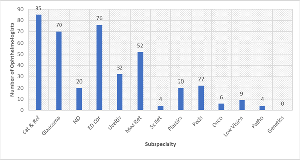Practice Profile and Geographical Distribution of Ophthalmologists in the Philippines
Authors
##plugins.themes.bootstrap3.article.main##
Abstract
Objectives: Determine practice profile, distribution, ophthalmology/population ratio (OPR), and density per region, and compare them based on the dimensions of eyecare services: availability, affordability, accessibility, and adequacy. Methods: A cross-sectional study of members and non-members of the Philippine Academy of Ophthalmology (PAO) from August to December 2022 using an online survey. Results: There were 1140 respondents, 636(58%) males. 979(86%) were actively practicing. 852(89%) hold only or predominantly private practice. 541(55%) were general ophthalmologists (GO). 134 respondents are still in training. Primary clinics were highest in the National Capital Region (NCR) (34%). 80% of all clinics of ophthalmologists are located in Luzon. Ophthalmologists held clinics in only 244(15%) municipalities/cities. 22% of municipalities/cities in Luzon, 9% in Visayas, and 8% in Mindanao had ophthalmologists. Conclusion: Almost all were seeing patients in practice or in training. Despite a slight male predominance, women ophthalmologists were >20-35% in Western countries. There was an increase in density to 15.6. NCR has the highest density (52.8), better than the United Kingdom (49) in 2012. Luzon had the highest density among the 3 major areas in the Philippines at 21.8, better than China’s 20 in 2016. Region 12 and the Bangsamoro Autonomous Region of Muslim Mindanao (BARMM) had low density.
##plugins.themes.bootstrap3.article.details##
Copyright (c) 2025 Roland Joseph D. Tan, MD, Roseny Mae C. Singson, MD, Maria Victoria A. Rondaris, MD

This work is licensed under a Creative Commons Attribution 4.0 International License.
Creative Commons License All articles published in Annals of Medicine and Medical Sciences are licensed under a Creative Commons Attribution 4.0 International License.
Roland Joseph D. Tan, MD, Community Ophthalmology Committee, Philippine Academy of Ophthalmology, Makati City, Metro Manila, Philippines. Department of Ophthalmology, Southern Isabela Medical Center, Santiago, Isabela, Philippines.
Community Ophthalmology Committee, Philippine Academy of Ophthalmology, Makati City, Metro Manila, Philippines.
Department of Ophthalmology, Southern Isabela Medical Center, Santiago, Isabela, Philippines.
Roseny Mae C. Singson, MD, Community Ophthalmology Committee, Philippine Academy of Ophthalmology, Makati City, Metro Manila, Philippines. Department of Ophthalmology, Asian Hospital and Medical Center, Alabang, Muntinlupa, Philippines
Community Ophthalmology Committee, Philippine Academy of Ophthalmology, Makati City, Metro Manila, Philippines.
Department of Ophthalmology, Asian Hospital and Medical Center, Alabang, Muntinlupa, Philippines
Maria Victoria A. Rondaris, MD, Community Ophthalmology Committee, Philippine Academy of Ophthalmology, Makati City, Metro Manila, Philippines. Faculty of Medicine & Surgery, University of Santo Tomas, Manila, Philippines.
Community Ophthalmology Committee, Philippine Academy of Ophthalmology, Makati City, Metro Manila, Philippines.
Faculty of Medicine & Surgery, University of Santo Tomas, Manila, Philippines.
[1] Resnikoff S, Felch W, Gauthier TM, Spivey B. The number of ophthalmologists in practice and training worldwide: a growing gap despite more than 200,000 practitioners. Br J Ophthalmol 2012 Jun;96(6):783-7.
[2] Resnikoff S, Lansingh VC, Washburn L, et al. Estimated number of ophthalmologists worldwide (International Council of Ophthalmology update): Will we meet the needs? Br J Ophthalmol 2020 Apr;104(4):588-592.
[3] Obamiro K, Jessup B, Allen P, et al. Considerations for Training and Workforce Development to Enhance Rural and Remote Ophthalmology Practice in Australia: A Scoping Review. Int J Environ Res Public Health 2022 Jul 14;19(14):8593.
[4] Feng PW, Ahluwalia A, Feng H, Adelman RA. National Trends in the United States Eye Care Workforce from 1995 to 2017. Am J Ophthalmol 2020 Oct; 218:128-135.
[5] Xulu-Kasaba Z, Mashige KP, Naidoo KS. An assessment of human resource distribution for public eye health services in KwaZulu-Natal, South Africa. African Vision Eye Health 2021;80(1): a583.
[6] Wang KM, Tseng VL, Liu X, Pan D, et al. Association Between Geographic Distribution of Eye Care Clinicians and Visual Impairment in California. JAMA Ophthalmol 2022 Jun 1;140(6):577-584.
[7] International Council of Ophthalmology. Data on Ophthalmologists Worldwide. 2017: http://www.icoph.org/ophthalmologists-worldwide.html (Accessed March 18, 2024).
[8] Department of Health. Universal Health Care | Department of Health website. 2011: https://doh.gov.ph/kalusugang-pangkalahatan (Accessed March 18, 2024).
[9] Arbisser L, Braga-Mele R, Donaldson K, et al. Roundtable: Women in ophthalmology. 2017: https://crstoday.com/articles/2017-apr/roundtable-women-in-ophthalmology (Accessed March 18, 2024)
[10] Xierali IM, Nivet MA, Wilson MR. Current and Future Status of Diversity in the Ophthalmologist Workforce. JAMA Ophthalmol 2016 Sep 1;134(9):1016-23.
[11] Lo TCS, Rogers SL, Hall AJ, Lim LL. Differences in the practice of ophthalmology by gender in Australia. Clin Exp Ophthalmol 2019 Sep;47(7):840-846.
[12] Philippine Statistics Authority. Highlights of the Philippine Population 2020 Census of Population and Housing (2020 CPH). 2021: https://psa.gov.ph/content/highlights-philippine-population-2020-census-population-and-housing-2020-cph (Accessed March 18, 2024).
[13] World Population Review. Poorest Countries in the World 2023. 2023: https://worldpopulationreview.com/country-rankings/poorest-countries-in-the-world (Accessed March 18, 2024).
[14] Tan RJD, Leon LP. The Cost of Managing Congenital Rubella Syndrome in a Tertiary Government Hospital in Northern Luzon, Philippines. Acta Med Philipp 2023Jan.31: https://actamedicaphilippina.upm.edu.ph/index.php/acta/article/view/4066 (Accessed March 18, 2024).
[15] Tan RJD, Dacuma MGB. Factors affecting childhood blindness and visual impairment in Baguio General Hospital and Medical Center. Phil J Health Res Dev 2021; 25(3), 54-63.

